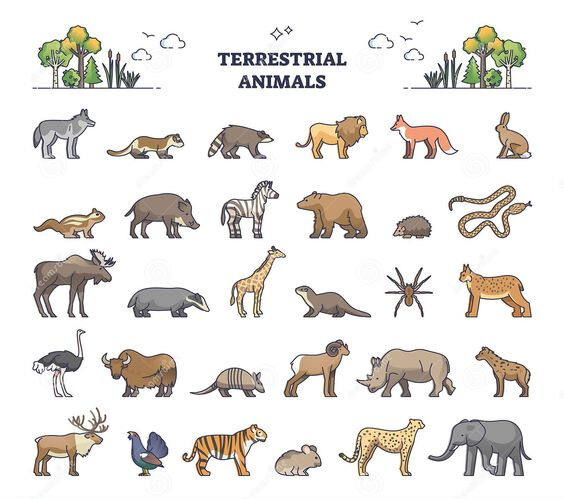Animals Living On Land
Key notes :
Definition of Terrestrial Animals

- Terrestrial animals are those that live primarily on land.
- They have adaptations that allow them to survive and thrive in land environments.
Characteristics of Land Animals
- Breathing: Most land animals have lungs for breathing air (e.g., mammals, reptiles).
- Movement: They have limbs like legs or wings to move on land. Examples include lions (legs) and birds (wings).
- Body Covering: They may have fur, feathers, or scales to protect their bodies. For example, mammals have fur or hair, while reptiles have scales.
Habitats of Land Animals

- Land animals can live in various habitats such as forests, deserts, grasslands, and mountains.
- Each habitat provides specific conditions like food, water, shelter, and climate that support different kinds of animals.
Adaptations for Survival
- Camouflage: Many land animals use camouflage to blend in with their surroundings and avoid predators. For example, chameleons change their color.
- Behavioral Adaptations: Some animals, like bears, hibernate to survive the winter when food is scarce.
- Physical Adaptations: Certain physical features, like thick fur in polar bears, help animals survive in specific environments.
Examples of Land Animals
- Mammals: Lions, elephants, dogs, and rabbits are examples of land mammals.

- Birds: Sparrows, eagles, and ostriches are birds that primarily live on land.

- Reptiles: Snakes, lizards, and turtles are examples of land reptiles.

- Insects: Ants, beetles, and butterflies are land-dwelling insects.

Role of Land Animals in the Ecosystem
- They help in pollination (e.g., bees), seed dispersal (e.g., birds), and control of insect populations (e.g., frogs).
- They are part of the food chain and play essential roles as predators, prey, or scavengers.
Conservation of Land Animals
- Many land animals are threatened due to habitat loss, pollution, and hunting.
- Conservation efforts include protecting habitats, creating wildlife reserves, and enacting laws to prevent poaching.
Fun Facts
- Giraffes are the tallest land animals.
- Elephants are the largest land animals.
- Cheetahs are the fastest land animals, capable of running up to 60-70 miles per hour.
Let’s practice!

